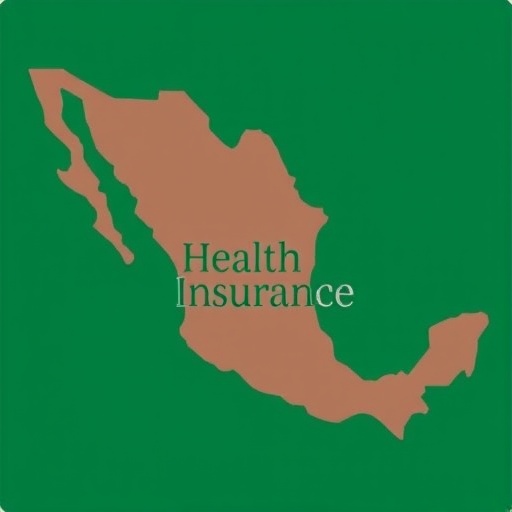Mexico’s Health Insurance: Advances, Gaps, and Future Challenges – Bioengineer.org

Analysis of Health Insurance Coverage in Mexico and its Alignment with Sustainable Development Goals
This report analyzes the progress, inequalities, and challenges concerning health insurance coverage in Mexico, with a specific focus on its implications for achieving the 2030 Agenda for Sustainable Development. The findings are based on the research by Serván-Mori et al., which examines the country’s journey toward Universal Health Coverage (UHC).
Progress and Challenges in Achieving SDG 3: Good Health and Well-being
Mexico’s efforts to expand health insurance coverage are central to achieving Sustainable Development Goal 3, particularly Target 3.8, which calls for UHC. While significant strides have been made, substantial challenges impede the realization of equitable and quality healthcare for all citizens.
Expansion of Health Insurance Coverage
Historically, health insurance was limited for lower-income populations. A major policy shift occurred with the introduction of Seguro Popular in the early 2000s, which dramatically increased the percentage of the population with health insurance. This initiative represented a critical step toward the principles of SDG 3.
Persistent Barriers to Universal Health Coverage
Despite increased enrollment, the effectiveness of coverage is undermined by several factors that contradict the goals of UHC and SDG 3.
- Inconsistent Quality of Care: Access to an insurance plan does not guarantee high-quality health services. A focus on enrollment numbers over service quality can lead to poor health outcomes and disillusionment among beneficiaries.
- Limited Access to Essential Services: Many insured individuals still face significant barriers when trying to access necessary health services, questioning the practical value of their coverage.
- Demographic Pressures: The health system is under increasing strain from an aging population and a rising prevalence of chronic conditions like diabetes and hypertension, complicating efforts to provide comprehensive care.
Inequalities in Health Access: A Challenge to SDG 10
The persistence of systemic inequalities is a primary obstacle to Mexico’s UHC ambitions and directly contravenes SDG 10 (Reduced Inequalities). These disparities manifest across multiple dimensions.
Regional and Socioeconomic Disparities
A significant urban-rural divide exists in healthcare access and quality. This geographical inequality is compounded by socioeconomic factors, creating a system where marginalized communities are consistently underserved.
- Urban Centers: Generally possess better availability and quality of health services and infrastructure.
- Rural Regions: Suffer from limited resources, geographical barriers, and systemic neglect, exacerbating health inequalities.
Financial Hardship and Out-of-Pocket Expenses
A key indicator of UHC failure is high out-of-pocket expenditure. Many Mexicans, despite being insured, face catastrophic health costs. This financial burden not only limits access to care but also risks pushing families into poverty, undermining SDG 1 (No Poverty).
Governance, Institutions, and Partnerships for Health
The Role of Governance in Health Policy (SDG 16)
Achieving UHC requires strong, stable, and transparent institutions, as outlined in SDG 16. In Mexico, political factors significantly impact health policy.
- Fluctuating Political Commitment: Changes in administration have led to health system restructuring, causing uncertainty for beneficiaries and undermining trust in public institutions.
- Need for Resilient Systems: The COVID-19 pandemic exposed systemic vulnerabilities, highlighting the urgent need for robust health infrastructure and a resilient insurance framework to protect populations during crises.
Recommendations for a Multi-Stakeholder Approach (SDG 17)
The path toward UHC2030 necessitates collaborative action and innovative solutions, aligning with SDG 17 (Partnerships for the Goals).
- Diversified Financing Mechanisms: To ensure sustainability, funding for health insurance must move beyond sole reliance on government budgets. Exploring public-private partnerships and international aid is essential.
- Enhanced Public Awareness: Many citizens are unaware of their insurance rights. Educational campaigns are crucial to empower individuals to seek and utilize available health services.
- Integrated Stakeholder Collaboration: Concerted efforts among policymakers, healthcare providers, and civil society are required to champion comprehensive reforms rooted in equity and transparency.
1. Which SDGs are addressed or connected to the issues highlighted in the article?
-
SDG 3: Good Health and Well-being
- The entire article is centered on the concept of Universal Health Coverage (UHC), which is a primary goal of SDG 3. It discusses Mexico’s journey toward providing health insurance and access to health services for its population. The text explicitly mentions the “quest for Universal Health Coverage (UHC)” and the goal of “UHC2030.” It also touches upon issues like the quality of care, access to essential services, and the rising prevalence of chronic conditions like diabetes and hypertension, all of which are central to SDG 3.
-
SDG 10: Reduced Inequalities
- The article repeatedly emphasizes the “stark inequalities in health access” in Mexico. It highlights disparities based on socioeconomic strata, geographical location (the “urban-rural divide”), and demographic factors. By focusing on how these inequalities prevent uniform and equitable access to healthcare, the article directly addresses the core mission of SDG 10, which is to reduce inequality within and among countries.
-
SDG 17: Partnerships for the Goals
- The article concludes by advocating for collaborative approaches and diversified funding to achieve UHC. It mentions the need for “public-private partnerships,” international aid, and effective collaboration between “policymakers, healthcare providers, and civil society.” This call for multi-stakeholder partnerships to achieve a sustainable goal directly aligns with the principles of SDG 17.
2. What specific targets under those SDGs can be identified based on the article’s content?
-
Targets under SDG 3
- Target 3.8: “Achieve universal health coverage, including financial risk protection, access to quality essential health-care services and access to safe, effective, quality and affordable essential medicines and vaccines for all.” The article is fundamentally an analysis of Mexico’s progress towards this target. It discusses the expansion of health insurance coverage, the persistence of “high out-of-pocket expenses” (financial risk), and challenges in providing “access to essential health services” and ensuring “quality of care.”
- Target 3.4: “By 2030, reduce by one third premature mortality from non-communicable diseases through prevention and treatment and promote mental health and well-being.” The article points to the “rising prevalence of chronic conditions such as diabetes and hypertension” as a demographic challenge that puts pressure on the health system, directly connecting to the need to manage non-communicable diseases.
- Target 3.d: “Strengthen the capacity of all countries, in particular developing countries, for early warning, risk reduction and management of national and global health risks.” The article uses the COVID-19 pandemic as an example that “underscore[s] the vulnerabilities within the health system.” It argues that the crisis should be a “learning opportunity” and that investment in healthcare infrastructure is essential for “future resilience against similar crises,” which aligns with this target.
-
Targets under SDG 10
- Target 10.2: “By 2030, empower and promote the social, economic and political inclusion of all, irrespective of age, sex, disability, race, ethnicity, origin, religion or economic or other status.” The article’s focus on expanding health programs to “include previously marginalized citizens” and overcoming inequalities faced by lower-income populations and those in rural regions relates directly to promoting social inclusion in the context of health.
- Target 10.3: “Ensure equal opportunity and reduce inequalities of outcome, including by eliminating discriminatory laws, policies and practices and promoting appropriate legislation, policies and action in this regard.” The discussion of “systemic inequalities” in the healthcare system and the need for “strategic policy interventions” to create a “uniformly accessible or equitable” system speaks to this target of reducing inequalities of outcome through better policy.
-
Targets under SDG 17
- Target 17.17: “Encourage and promote effective public, public-private and civil society partnerships, building on the experience and resourcing strategies of partnerships.” The article explicitly advocates for “diversified funding streams,” including “public-private partnerships or international aid,” and calls for policymakers, providers, and civil society to “partner effectively to champion comprehensive health reforms.”
3. Are there any indicators mentioned or implied in the article that can be used to measure progress towards the identified targets?
-
Indicators for SDG 3 Targets
- For Target 3.8: The article mentions several direct and indirect indicators.
- Percentage of the population with health insurance: The article states that this percentage “has dramatically increased,” which is a direct measure of service coverage (related to Indicator 3.8.1).
- Level of out-of-pocket expenses: The mention of “high out-of-pocket expenses” is a key indicator of financial risk protection (related to Indicator 3.8.2).
- Access to essential health services: The article notes that many face “limited access to essential health services,” which is a core component of Indicator 3.8.1.
- Quality of care: The article raises concerns about the “quality of care,” suggesting that quality assurance measures are a necessary, albeit qualitative, indicator for effective coverage.
- For Target 3.4: The “rising prevalence of chronic conditions such as diabetes and hypertension” is mentioned as a key challenge. This prevalence rate serves as an implied indicator of the burden of non-communicable diseases that the health system must manage.
- For Target 3.8: The article mentions several direct and indirect indicators.
-
Indicators for SDG 10 Targets
- For Targets 10.2 and 10.3: The article implies that progress can be measured by tracking disparities in health access.
- Disparities in healthcare access between urban and rural regions: The “urban-rural divide” in the “availability and quality of health services” is presented as a clear indicator of inequality.
- Disparities in health access across socioeconomic strata: The article’s initial premise is the historical lack of insurance for the “lower-income population,” making the level of coverage for this group an indicator of reduced inequality.
- For Targets 10.2 and 10.3: The article implies that progress can be measured by tracking disparities in health access.
-
Indicators for SDG 17 Targets
- For Target 17.17: The article implies progress can be measured by the implementation of new partnership and funding models.
- Number and value of public-private partnerships in health: The call to explore “public-private partnerships” suggests that their establishment would be a positive indicator.
- Diversification of health funding sources: The amount of funding secured through “international aid” or other innovative solutions beyond government funding would serve as an indicator of progress.
- For Target 17.17: The article implies progress can be measured by the implementation of new partnership and funding models.
4. Create a table with three columns titled ‘SDGs, Targets and Indicators” to present the findings from analyzing the article.
| SDGs | Targets | Indicators (Mentioned or Implied in the Article) |
|---|---|---|
| SDG 3: Good Health and Well-being |
3.8: Achieve universal health coverage.
3.4: Reduce premature mortality from non-communicable diseases. 3.d: Strengthen capacity for managing national and global health risks. |
– Percentage of the population with health insurance. – Level of out-of-pocket expenses. – Degree of access to essential health services. – Measures of quality of care. – Prevalence rates of chronic conditions (diabetes, hypertension). – Level of investment in healthcare infrastructure for crisis resilience. |
| SDG 10: Reduced Inequalities |
10.2: Promote social, economic, and political inclusion of all.
10.3: Ensure equal opportunity and reduce inequalities of outcome. |
– Disparity in health service availability and quality between urban and rural regions. – Disparity in health coverage and access across different socioeconomic strata. |
| SDG 17: Partnerships for the Goals | 17.17: Encourage and promote effective public, public-private and civil society partnerships. |
– Number and effectiveness of public-private partnerships in the health sector. – Level of diversification in funding streams (e.g., international aid, private investment). – Existence of collaborative platforms for policymakers, providers, and civil society. |
Source: bioengineer.org
What is Your Reaction?
 Like
0
Like
0
 Dislike
0
Dislike
0
 Love
0
Love
0
 Funny
0
Funny
0
 Angry
0
Angry
0
 Sad
0
Sad
0
 Wow
0
Wow
0



















































.jpg.webp?itok=0ZsAnae9#)

























